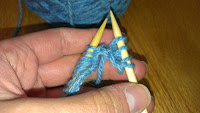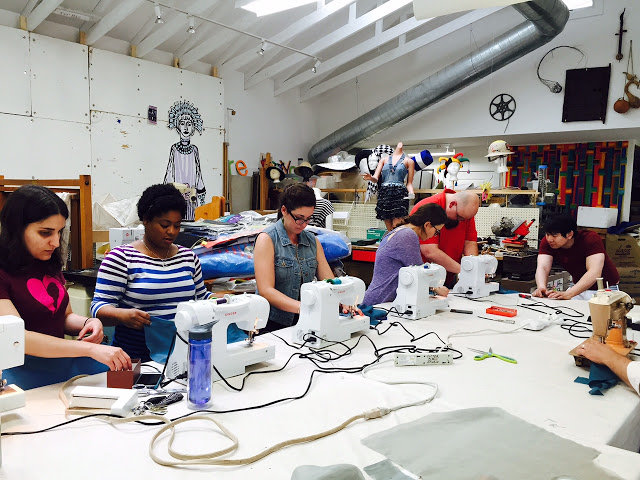I’ve decided to write some reflections on running an online course on Social Inequality (Sociology) that I co-designed and taught with…
Archive | June, 2015
Creativity Labs Learns to Knit
This is the second in a series of blog posts about the Creativity Labs’ fiber arts summer workshops. The workshops are experiential opportunities to learn new crafting skills, which have connections to the current Re-Crafting Education project. We are learning from and working with experienced crafters in the community to strengthen our understanding of and connection to the regional fiber arts community.
In this second workshop, the Creativity Labs team took on the next fiber arts challenge during a group knitting lesson at Yarns Unlimited in downtown Bloomington, IN. The local yarn shop has been a key site for observation and instruction during the Re-Crafting project, and offers both a rich collection of beautiful, soft and colorful materials and fiber arts classes for crafters in the community, including knitting, crocheting, and weaving among many more. In addition to the playful storefront, where fibers, yarns and felt as well as knitting needles of all sizes and books inspire to make, the shop contains a classroom dedicated to fiber arts lessons.
The crafting classroom at Yarns Unlimited.
The teaching staff comprises of passionate, skilled and dedicated knitters, crocheters, and weavers. Our instructor, Karen Canapa, has been knitting and crocheting most of her life, attesting to its therapeutic benefits. She works with fiber artists of all levels, but is particularly patient throughout the (sometimes frustrating) first minutes of a new knitter’s quest to get in the loop. Her extensive work with beginner knitters has given her the opportunity to observe and to design effective and fun instructions for a knitter’s first lesson.
Here is a glimpse of what we learned when we picked up our needles:
- The Slip Knot: To start a new project, the knitter can make the first loop to slip onto the knitting needles. This loop is called a slip knot, and the yarn “slips” right onto the needle as the knitter prepares the project. Karen warned us that the slip knot can be “super tricky” to make - we agree with her!
“The [slip knot] is a small knot that leaves a loop on one end,” Karen explained, “and if you pull the two ends, the knot completely disappears. So, it allows us to have a variable size beginning stitch.”
From left to right: Karen shows Anna another variation of the slip-knot technique. Sophia practices making slip knots in the crafting classroom.
- The Cast-On: The first row of a knitted project is the row that is cast onto the needle by the knitter. The knitter will put both needles into the slip knot to make an “X” shape.


From left to right: Putting the needles through the slip knot. Folding the yarn over the needle to prepare for the first stitch. Starting the second row of stitches.
- The Knit and Purl: Knitting consists of two basic stitches: knit stitches and purl stitches. The first stitch the beginner knitter learns is the knit. A series of knit stitches is called the garter stitch pattern. We learned to knit a few rows of knit stitches. We also worked together fix some of our mistakes. In doing so, we were able to see that knitting is actually a process of crafting that generates loops, instead of knots (as some may think). A row of stitches is essentially a connected line of loops! After learning the knit stitch, Karen taught us the purl stitch, which can be thought of as a reverse knit stitch.
Sophia learns to knit and purl across the row on her stitches.
These 3 techniques work together to form a knitter’s first tool kit. The knit stitch itself can be used to create an extensive collection of projects. Together, we learned that the first moments of knitting can be complex and challenging, but as one of us (Kate) writes about in her first weeks as an embedded knitter, mistake-making is a valuable component of the learning process. Karen recommends 15 minutes of practice a day to develop a natural flow to your knitting practice. It may only be a matter of time before the Creativity Labs knits a matching team uniform.
Building Your Education Digital Footprint http://t.co/ksCfVcJ3wp by @chrkennedy #DMLcommons #digitalidentity
— Connected Learning Lab (@CLLab) June 8, 2015
Fiber Arts: Sewing with Gail Hale
A post by Sophia Bender, Tony Phonethibsavads, Naomi Thompson, and Anna Keune
This is the first in a series of blog posts about the Creativity Labs’ fiber arts summer workshops. Tucked away on the eastern side of Bloomington, the CL team attended a workshop to learn how to use the sewing machine by artist, self-acclaimed maker and innovative recrafter, Gail Hale. Gail worked with the Creativity Labs team several times in the past, including assisting the creation of a cosplay costume as part of the Re-Crafting Mathematics project. This project was the overall frame for our sewing workshop at her private makerspace. As an artist of the Discardia group, that repurposes discarded materials into refashioned wearables, our workshop project was in true discardia style: sewing a grocery bag out of sheer synthetic fabric, which was repurposed from curtains.
The wonder-filled studio, with painting and dried out beehives dangling from the ceiling right over mannequins wearing hats and dressed in fashion projects in progress and former Trashion Refashion outfits, a fridge covered with reused magnets and shelves stacked with fabrics for projects to come, we gathered around a large and heavy wooden table, eager to learn.
To get started, Gail laid out the metal pattern used to cut the bag-shaped cloth for the project. The sheer fabric was slippery, and Gail fastened the pattern tightly onto the fabric, using old metal irons and pieced of railroad tracks that she gathered and cut apart years ago from a former workshop. To prevent the fabric from fraying, Gail recommended to use a woodburning tool to cut the fabric along the metal pattern, neatly sealing the synthetic fabric’s edges.
From left to right: Metal irons and railroad track pieces hold down the pattern. Kate practices her cutting skills. Kate adjusts the fabric before sewing.
Next, it was our turn. Rotating around the group, one by one, each of us carefully stepped towards the pattern and cut a small area. While this is a rather unconventional method for cutting fabric, it was an innovative use for old tools, underscoring Gail’s spirit of making. Moving forward, to save time, Gail provided each with pre-cut fabric pieces.
Janis at Gail’s old Singer machine.
Ready to get our hands on the sewing machines, we all followed the same order to sew our shopping bags. First, we sewed up each of the sides, before moving on to the handles. Some of us decided to sew two “triangles” into the inside bottom of the bags to create a flat bottom and we learned a new term from our newest team members, Ed Gentry: We called this boxing it up. For the handles, Gail suggested a really neat trick to provide extra reinforcement and to flatten the seams so they would lie comfortably against your shoulder. This involved sewing along the handles once, then opening the seam and sewing each side down. However, some of us had sewed our seams too tiny to use this technique! She also said the sides of the triangles be sewn down to provide a more finished, secure look. Some of us opted to do that, and some didn’t.
This fun workshop that kicked off the Creativity Labs summer series of fiber arts activities not only enriched our understanding of the intricate and fascinating craft of sewing, but also gave us a chance to learn more about each other, our past experiences and our interests moving forward as a research team. Thanks so much to Gail for helping us out!
Fiber Arts: Sewing with Gail Hale
A post by Sophia Bender, Tony Phonethibsavads, Naomi Thompson, and Anna Keune
This is the first in a series of blog posts about the Creativity Labs’ fiber arts summer workshops. Tucked away on the eastern side of Bloomington, the CL team attended a workshop to learn how to use the sewing machine by artist, self-acclaimed maker and innovative recrafter, Gail Hale. Gail worked with the Creativity Labs team several times in the past, including assisting the creation of a cosplay costume as part of the Re-Crafting Mathematics project. This project was the overall frame for our sewing workshop at her private makerspace. As an artist of the Discardia group, that repurposes discarded materials into refashioned wearables, our workshop project was in true discardia style: sewing a grocery bag out of sheer synthetic fabric, which was repurposed from curtains.
The wonder-filled studio, with painting and dried out beehives dangling from the ceiling right over mannequins wearing hats and dressed in fashion projects in progress and former Trashion Refashion outfits, a fridge covered with reused magnets and shelves stacked with fabrics for projects to come, we gathered around a large and heavy wooden table, eager to learn.
To get started, Gail laid out the metal pattern used to cut the bag-shaped cloth for the project. The sheer fabric was slippery, and Gail fastened the pattern tightly onto the fabric, using old metal irons and pieced of railroad tracks that she gathered and cut apart years ago from a former workshop. To prevent the fabric from fraying, Gail recommended to use a woodburning tool to cut the fabric along the metal pattern, neatly sealing the synthetic fabric’s edges.
From left to right: Metal irons and railroad track pieces hold down the pattern. Kate practices her cutting skills. Kate adjusts the fabric before sewing.
Next, it was our turn. Rotating around the group, one by one, each of us carefully stepped towards the pattern and cut a small area. While this is a rather unconventional method for cutting fabric, it was an innovative use for old tools, underscoring Gail’s spirit of making. Moving forward, to save time, Gail provided each with pre-cut fabric pieces.
Janis at Gail’s old Singer machine.
Ready to get our hands on the sewing machines, we all followed the same order to sew our shopping bags. First, we sewed up each of the sides, before moving on to the handles. Some of us decided to sew two “triangles” into the inside bottom of the bags to create a flat bottom and we learned a new term from our newest team members, Ed Gentry: We called this boxing it up. For the handles, Gail suggested a really neat trick to provide extra reinforcement and to flatten the seams so they would lie comfortably against your shoulder. This involved sewing along the handles once, then opening the seam and sewing each side down. However, some of us had sewed our seams too tiny to use this technique! She also said the sides of the triangles be sewn down to provide a more finished, secure look. Some of us opted to do that, and some didn’t.
This fun workshop that kicked off the Creativity Labs summer series of fiber arts activities not only enriched our understanding of the intricate and fascinating craft of sewing, but also gave us a chance to learn more about each other, our past experiences and our interests moving forward as a research team. Thanks so much to Gail for helping us out!











